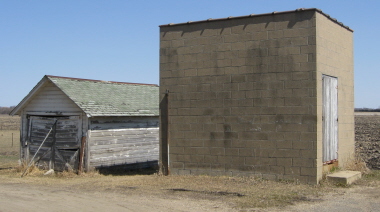



Steele County Minnesota used to be billed as the "Butter Capital of the World". In the 20's and 30's there were more than two dozen small co-op creameries like this one operating in the county - shipping their product all over the country. However, pasture land eventually gave way to fields of row crops, and the creameries lost their prime ingredient (milk, duh). By 1975, there were just two old-fashioned creameries left in the area. And nowadays, there's just the one (one of only two left in the entire state).
The first Hope creamery (Midway Creamery) was actually moved from neighboring Lemond in 1910 (presumably to take advantage of the new rail line). In 1919, the old creamery was demolished and this two-story structure was built in its place. The second floor was used for many years as a sort of community hall, providing space for meetings, dances and other social gatherings. It doesn't appear to be used for anything like that anymore, though. In fact, based on the broken windows up there, I actually thought this place was closed down and abandoned when I first saw it.
Co-op creameries rely heavily on their "patrons" (the farmers with the cows). To entice said patrons to continue bringing their milk to Hope, the creamery purchased Hope Co-Op Oil (1975) and Hope Hardware (1989). This allowed them to offer a wider range of services. In addition to various fuels, Hope Coop Oil also provided feed, seed and various farm supplies. The hardware store was a short-lived investment, ultimately being sold off in 1999.
By the end of the 90's, things were looking pretty grim for the Hope Co-Op Creamery. Overall demand for butter was down, profits were practically non-existant, and the co-op patrons were starting to get antsy. Eugene Kruckeberg (Hope's buttermaker since 1964) was contemplating retiring. And with no one set to replace him, it looked like the end of the line for this venerable institution. Then along came Victor Mrotz.
Mrotz and his wife moved to the area from the Twin Cities with the idea of getting back to their family's farming roots. Well, that didn't quite work out. And while looking for other ways to invest their money, they came across the Hope Co-Op and decided to purchase it (2001). One of Mrotz's first moves was to sell off all the non-creamery assets (IE, the co-op oil operation). Mrotz brought a lot of new ideas and new vigor to the table, and thanks to a lot of positive publicity, Hope's unique brand of butter (now marketed as "organic") is finding it's way into upscale restaurants and grocery stores all over the region.
As pictured above, operating even a small creamery involves a lot of trucks. Milk must be picked up from the patrons, butter must be delivered to distributors, and unused dairy products must be shipped to other processing facilities. Up until the 90's, whole milk was brought directly to the creamery. The cream was separated out and the skimmed milk was shipped to other processors. Not being "Grade A" milk, it could only be used for cheese (a product that the Hope creamery has never dabbled in). Nowadays, the whole milk is trucked to other facilities where the cream is separated out and then delivered to Hope. The Hope creamery can churn about 2,800 lbs of butter in a given day. Current demand is such that butter is only made one day a week (Wednesday).
I recently started buying Hope butter (available at our local Lund's grocery store), and it really is something special. The "old fashioned" taste has to do primarily with the amount of salt added (relatively high) and the citric acid based "butter starter" they use (which gives it its rich flavor). It also has to do with how the butter is churned. Hope butter is churned in multiple stages, and churned slow. Larger plants, which produce as much as 500,000 pounds of butter a day, use a faster, continuous churn. After trying Hope butter, I find mass-produced butter to be flat and flavorless by comparison. If you ever get a chance to try Hope butter, go for it! No longer distributed as widely as it was in the 30's and 40's, people literally drive here from all over the country in order to stock up.
Addendum - Eugene Kruckeberg passed away on July 25th, 2017 at the age of 78. And he never did retire - still riding his bicycle to the creamery at 5:00 AM every Wednesday to make butter by hand.
Hope Creamery circa 1920 -

Here's how the model compares to the original -










I'm not sure if I'm going to be doing these out buildings or not. Depends on how much space I wind up with...

 Send email to the spooks! |